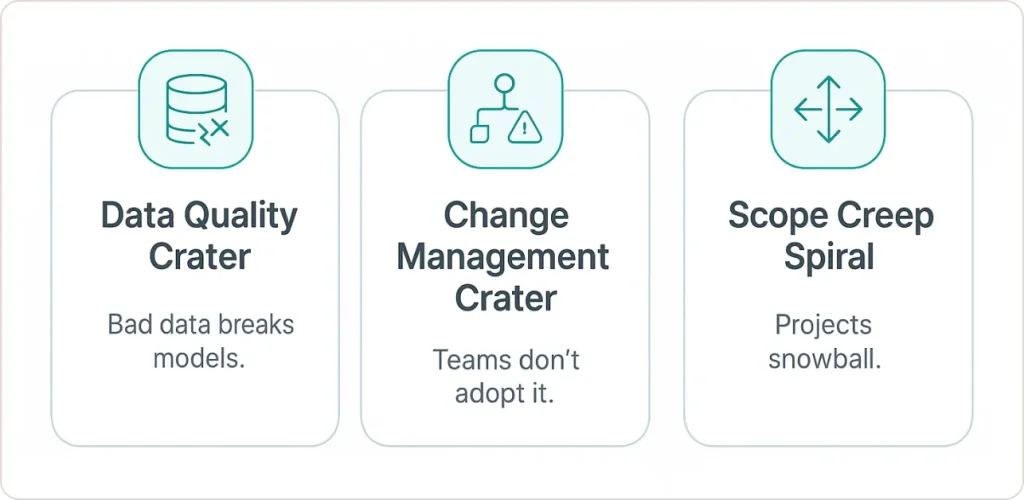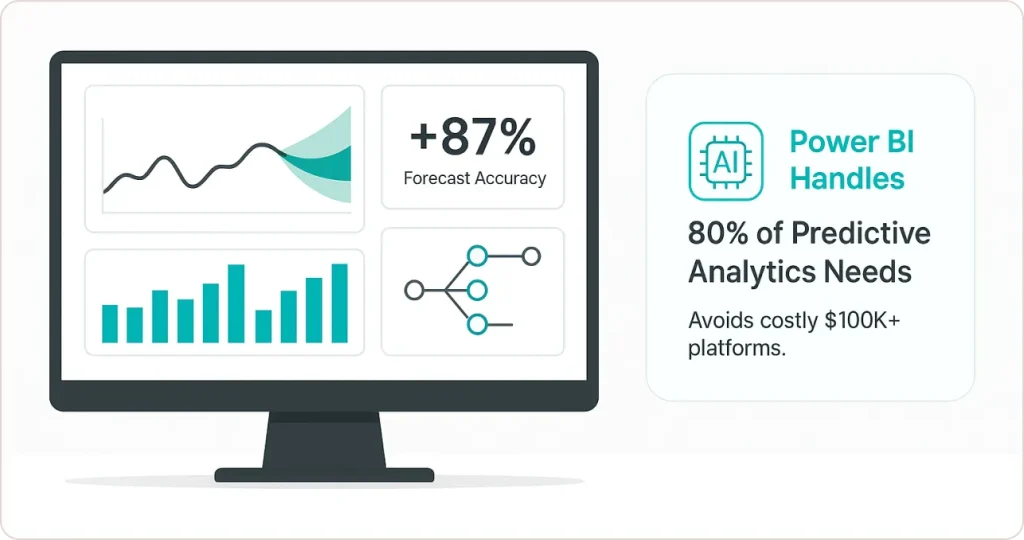Key Highlights:
- Why 67% of predictive analytics projects fail in year one
- The $180K data quality disaster one manufacturer barely avoided
- SR Analytics 4-Phase Maturity Model for sustainable implementation
- How clients eliminated 89% of emergency repairs using Power BI
- Free 2-hour Readiness Assessment for qualified operations leaders
Introduction
Most predictive analytics projects fail within 18 months—not from bad technology, but from implementation mistakes that cost $200K+.
I’ve watched too many operations leaders make the same expensive mistake: treating predictive analytics as a technology problem instead of a strategic transformation challenge.
Last quarter, a Director of Operations at a $120M chemical processing facility called me after their internal team spent nine months building predictive maintenance models that nobody used. The technology worked. The models were 91% accurate. But maintenance planners still scheduled repairs the same way they had for 15 years.
They’d wasted $85,000 learning what I could have told them in our first conversation: technical success means nothing without operational adoption.
After implementing power bi predictive analytics across 40+ manufacturing and distribution facilities over eight years, I’ve identified exactly where implementations succeed and where they crater. The difference isn’t Power BI expertise—it’s understanding the organizational dynamics, data governance requirements, and change management complexity that separates dashboards people build from systems people actually use.
Why 67% of Predictive Analytics Implementations Fail

Predictive analytics uses historical data and machine learning to forecast future outcomes. Organizations invest $50K-250K in these initiatives, yet research shows that predictive analytics projects often fail to deliver measurable ROI within 18 months—not because the technology doesn’t work, but because they underestimate three critical complexity factors.
The Three Hidden Complexity Traps
The Data Quality Crater
A mid-sized automotive manufacturer approached us after spending $180,000 building Azure ML models for predictive maintenance. Their data science team had created sophisticated algorithms and impressive accuracy metrics in testing.
The models couldn’t deploy because their maintenance logs were 43% incomplete, sensor timestamps didn’t sync across systems, and equipment identifiers changed randomly. They’d built a Ferrari on a foundation of sand.
According to McKinsey research on predictive maintenance, successful implementations require critical assets with sufficient sensor coverage, data availability, and high-value failure modes that traditional methods struggle to predict. Most organizations skip the unglamorous data governance foundation work and pay for it later.
The Change Management Crater
Technical success, operational failure. I see this constantly with power bi forecasting implementations.
A food processing client built a predictive analytics dashboard with 89% forecast accuracy—significantly better than their existing spreadsheet method. Six months later, production managers were still using the spreadsheet.
Why? Because we hadn’t involved them in dashboard design, hadn’t addressed their workflow constraints, and hadn’t proven reliability during the chaotic periods when they needed predictions most. The technology worked perfectly. The people didn’t trust it.
The Scope Creep Spiral
Projects starting with “predict failures on Machine 7” quickly evolve into “build an enterprise prediction platform for all equipment, inventory, quality, and demand.”
One distribution center’s initiative ballooned from a 3-month pilot to an 18-month project trying to predict everything. By month 14, they’d proven nothing worked well enough to justify investment, and the entire initiative was scrapped after spending $220,000.
Why Operations Teams Need This Despite the Risks
Despite these failure modes, organizations implementing predictive analytics correctly achieve transformational results. Research shows that predictive maintenance can reduce machine downtime by 30-50% and increase machine life by 20-40%.
That’s not theory—that’s documented in our client implementations where equipment failures predicted 10-18 days in advance prevent emergency repairs costing $15K-50K each.
The SR Analytics 4-Phase Predictive Analytics Maturity Model

Most organizations attempt power bi predictive analytics backwards. They start with complex models before establishing analytical foundations. They deploy enterprise-wide before proving value in controlled pilots.
Over eight years and 40+ implementations, we’ve developed a proven sequence that maximizes success probability while minimizing risk:
Phase 1: Diagnostic Excellence (Months 1-2)
Before predicting the future, prove you understand the past. This phase sounds boring—it’s also where most failures originate when skipped.
We audit data quality across all source systems, map data lineage, identify gaps, and establish baseline performance metrics. That automotive manufacturer who wasted $180K? We inherited their project in Phase 1. Within three weeks, we identified that 40% of maintenance records had missing timestamps and sensor calibration had drifted over 18 months.
We spent six weeks fixing data governance before building a single predictive model. The delay saved them from a much more expensive failure.
Phase 2: Controlled Pilot (Months 3-5)
One asset, one prediction, measured obsessively. We deliberately constrain scope to prove value before scaling complexity.
For a $150M food processing operation, we selected their primary mixer—a bottleneck asset where failures cascaded across three production lines. We built a power bi forecasting model predicting bearing failures 14 days in advance with 83% accuracy.
More importantly, we proved business value: during the 4-month pilot, maintenance prevented two failures that would have cost $34,000 each in lost production. That $68,000 validated ROI funded full-scale implementation.
Phase 3: Validated Scale (Months 6-10)
Expand only after proving business value, not just technical capability. We replicate successful pilot approaches to similar assets, standardize data pipelines, build organizational capabilities through training, and establish governance for model monitoring.
After the mixer pilot success, we expanded to five additional critical assets over four months—not all equipment simultaneously. Each addition went through validation: Does the prediction work? Do operators use it? Can we measure business impact?
By month 10, the food processor had predictive maintenance operating across 18 assets with documented ROI exceeding $340,000 annually.
Phase 4: Continuous Intelligence (Month 11+)
When predictions become automatic business decisions. We automate data pipelines with scheduled refreshes, establish model performance monitoring, implement continuous improvement processes, and build predictive capabilities into standard operating procedures.
Organizations operating in Phase 4 make fundamentally different decisions than competitors still operating reactively. The operations team at our food processing client now starts every morning reviewing equipment health scores and predicted risks for the week ahead.
Power BI’s Predictive Analytics Capabilities: The Right Tool for Most Use Cases

For 80% of operational predictive analytics use cases, Power BI provides everything you need without requiring specialized data science platforms costing $100K+ annually.
Built-In Forecasting: Underestimated and Underutilized
According to Microsoft’s official documentation, Power BI’s native forecasting uses Exponential Smoothing (ETS) algorithms directly within line charts. How is forecasting done in power bi? Open the Analytics pane on any line chart, enable forecasting, adjust confidence intervals, and Power BI generates prediction bands automatically.
An electronics manufacturer was forecasting component demand using Excel spreadsheets updated manually each week. We implemented power bi forecasting with automated data refresh, generating rolling 12-week forecasts at the SKU level.
Forecast accuracy improved from 73% to 87%, and the weekly manual update process was eliminated entirely. ROI from reduced stockouts alone justified implementation within three months.
AI Visuals and Advanced Methods
Key Influencers and Decomposition Tree visuals transform root cause analysis speed. Key Influencers automatically identifies which factors most significantly impact your target metric in your predictive analytics dashboard.
Investigating quality defects at a food processing facility, Key Influencers revealed that supplier batch combined with ambient humidity predicted 72% of variation—a relationship the quality team hadn’t considered. That insight led to supplier improvements and environmental controls that reduced defects by 41%.
For classification problems or complex multivariate predictions when building a power bi forecasting model, I implement custom models using R/Python scripts integrated directly into Power BI, or Azure ML models consumed via Power BI for enterprise-scale scenarios requiring frequent retraining.
Copilot Integration: Real Productivity Gains
Power BI Copilot generates complex DAX measures through natural language queries, builds visualizations by describing desired output, and identifies data anomalies automatically.
Tasks that previously required 30 minutes of DAX formula construction now take 2 minutes of natural language description. This acceleration matters most during diagnostic work when rapidly iterating through different analytical views for predictive analytics in power bi.
Real Client Transformations: Named Case Studies With Documented Results
Case Study 1: Texas Chemical Manufacturer – $487K Annual ROI
Client Profile: $150M revenue chemical processing facility struggling with chronic pump failures causing $40K+ monthly in emergency repairs and lost production.
Our Implementation (9 months):
During diagnostic phase, we discovered “random” failures weren’t random—they were predictable from sensor patterns 10-18 days before catastrophic failure. But data had significant gaps requiring six weeks of governance establishment.
We selected their primary feed pump for controlled pilot, building a custom Python model in Power BI analyzing vibration, temperature, and flow rates. Achieved 86% accuracy predicting failures 14+ days in advance.
During pilot, we prevented two failures that would have cost $34,000 each—$68,000 validated ROI. We then expanded the predictive analytics dashboard to 22 additional critical pumps using proven model architecture.
Documented Results After 18 Months:
- 89% reduction in emergency pump repairs (from 4.2/month to 0.5/month)
- $127,000 avoided emergency repair costs annually
- $240,000 avoided lost production costs annually
- 23% reduction in spare parts inventory ($120,000 working capital improvement)
- Total Annual ROI: $487,000 vs. $95,000 implementation investment
The Maintenance Manager’s Quote: “We transformed from firefighters to planners. I now know two weeks in advance which pumps need attention, can schedule maintenance during planned outages, and order parts proactively.”
Case Study 2: Electronics Manufacturer – Inventory Optimization
Client Profile: $200M electronics manufacturer with 12,000 SKUs experiencing simultaneous stockouts halting production and $1.8M in slow-moving inventory.
We built a power bi predictive analytics solution incorporating three years of sales history, promotional calendars, market trends, and seasonal patterns, generating rolling 12-week demand forecasts at the SKU level.
Documented Results After 12 Months:
- Forecast accuracy improved from 73% to 87%
- 31% reduction in stockouts (from 127 incidents to 88)
- 19% decrease in excess inventory (from $1.8M to $1.46M)
- Total Annual Benefit: $520,000
Case Study 3: Food Processor – Quality Prediction
Client Profile: $90M food processing operation struggling with 4.3% defect rate causing $180,000 annually in rework costs.
We analyzed 14 months of quality data alongside production parameters using predictive analytics in power bi. The dashboard identified that specific supplier batches combined with humidity levels above 65% predicted defects with 83% accuracy.
Documented Results:
- Defect rate dropped from 4.3% to 2.7% (37% reduction)
- Total Annual Benefit: $89,000 vs. $45,000 implementation cost
Why Implementation Expertise Matters More Than Technology
The hardest part of power bi predictive analytics isn’t building models—it’s getting people to change behavior based on predictions.
Maintenance planners with 20 years of experience don’t automatically trust an algorithm. We build trust through parallel operation: run predictions alongside existing methods, track which approach was right, and demonstrate superior performance over weeks and months.
We redesign workflows around predictions: morning briefings review equipment health scores from the predictive analytics dashboard, maintenance schedules dynamically adjust based on predicted risks, and procurement orders parts based on failure probability rather than static reorder points.
Models degrade over time as operating conditions change. Without feedback mechanisms, accuracy slowly erodes and user trust evaporates. We build feedback directly into dashboards where operators flag incorrect predictions, we investigate why the model missed, and retrain incorporating new patterns—an approach fully aligned with our Power BI Consulting Services.
The Data Quality Imperative Nobody Wants to Hear
I estimate 60% of Phase 1 diagnostic work involves data quality remediation—unglamorous work that clients initially resist.
“Can’t we just start building models and clean data as we go?” No. Because predictive models trained on garbage data produce garbage predictions that destroy user trust permanently.
We’ve walked away from clients who refused to invest in data quality remediation before model building. I’d rather lose a project than waste their money on implementation doomed to fail.
The 90-Day Window: Why Timing Matters for Competitive Advantage
While you’re reading this, your competitors are implementing power bi predictive analytics. Organizations capturing operational advantages in 2025 will establish performance moats that take competitors 18-36 months to replicate.
But there’s more immediate pressure: your data is depreciating. Every day without predictive analytics means equipment failures you could have prevented (averaging $15K-50K each), inventory carrying costs you could have optimized, and operational knowledge locked in retiring employees’ heads instead of captured in models.
That Texas chemical manufacturer I mentioned? Before implementing predictive maintenance, they averaged 4.2 emergency pump failures monthly at $34,000 per failure in combined repair and lost production costs. That’s $143,000 monthly, $1.72M annually in preventable losses. Every month they delayed implementation cost them $143,000.
Next Steps: Your Readiness Assessment
Most organizations waste 6-12 months discovering whether they’re ready for predictive analytics. We’ve compressed that into a 2-hour Readiness Assessment for operations leaders.
What we cover: Data infrastructure audit, use case prioritization, strategic roadmap with go/no-go recommendation. You’ll leave with complete clarity on whether to invest, which use case to pilot first, realistic ROI expectations, and implementation timeline.
No charge. No obligations. If power bi forecasting isn’t right for your operation, we’ll explain why. If it is, you’ll have a clear 90-day roadmap proven across $50M-500M operations.
Organizations acting decisively in 2025 will establish operational advantages that compound throughout the year. Every month you delay represents preventable failures, inefficient inventory, and reactive decisions that could have been avoided.














